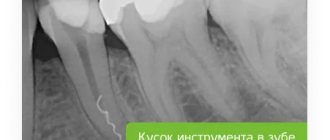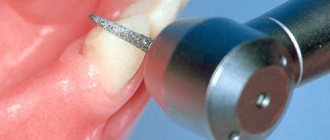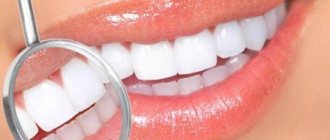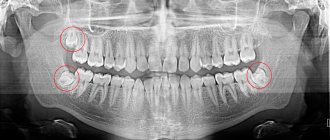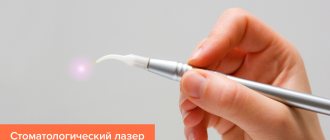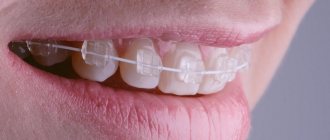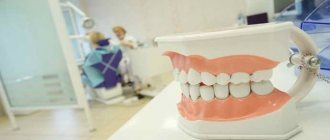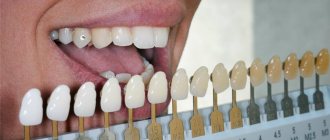10668
Teeth filing technology has been used in dental practice since the beginning of the 19th century. At that time, this procedure was used as a preservative during the treatment of caries.
With the improvement of therapy methods and the expansion of the list of instruments used, this treatment technology was abandoned, however, in some situations, filing is still used.
Indications
There are opposing opinions among dentists regarding the procedure, but there are situations in which filing is necessary:
- When installing crowns. For reliable fixation of the crown, it must fit tightly to the tooth surface.
Since the anatomical shape of each molar or incisor is not ideal, grinding down of the upper layers of their hard tissue is required. This allows you to give your own bone organ the correct geometric shape, thanks to which the manufactured product is firmly fixed and does not stand out among other elements of the jaw row. - For fixing veneers. Ceramic plates fixed to the surface of your own teeth have a certain thickness.
Therefore, in order for the installed microprostheses to fit firmly and not protrude beyond the boundaries of the native units, a small amount of hard tissue is ground off from the vestibular side of the elements of the jaw row. - Preparation for inlays. If it is necessary to mask the cavity formed as a result of carious lesions, ceramic or metal inlays can be used.
Their fixation requires the creation of side walls and the formation of the required depth near the cavity. - In case of installation of an orthodontic structure. Cutting down a small thickness of the top layer of the tooth allows you to make room for correcting the position of the remaining elements of the row without the need to remove them.
In addition, this option is often used in cases of increased crowding of teeth, since it facilitates the placement of fastening elements of the bracket system on them. - If there is damage to the enamel. Chips on the surface of the front incisors can be made less noticeable by slightly filing down the enamel.
This improves the aesthetics of the appearance of the jaw row and eliminates the need for composite restoration. - In case of elongated incisors. If the front teeth are longer than the rest of the row, this can not only cause psychological discomfort, but also interfere with correct diction or complete chewing of food.
To solve the problem, in some cases, filing the length of organs protruding from the common line is used. - At sharp angles. The anatomical structure of the anterior incisors is not always ideal. If there are sharp corners, dentists may recommend filing them down, which will increase the aesthetic appearance of the entire jaw row.
Indications for the use of orthoimplants and tactics for their installation.
Let's discuss here how the braces system works.
At this address https://orto-info.ru/ortodonticheskoe-lechenie/podgotovitelnyiy-period/separatsiya-zubov.html we will talk about abrasive teeth separation.
Butterfly prosthesis
The design was named because of its external resemblance to a butterfly. Used when 1-2 units are missing. Consists of a crown and a base. This is a denture without turning; it is attached to adjacent teeth with clasps.
Materials:
- Classic polymers: acrylic, nylon
- Innovative polymers: Acry Free, Dental D
The prosthesis does not participate in the distribution of chewing load and does not prevent bone loss. It is quite fragile and cannot be repaired. They use it as a temporary measure, although they can last one to two years.
Contraindications
The necessity and admissibility of filing teeth is determined by the dentist individually in each case, since the procedure is quite labor-intensive and can be traumatic in some situations.
For this reason, sewing hard fabric is contraindicated in the following situations:
- increased abrasion of enamel;
- hyperesthesia;
- bruxism;
- presence of bad habits - frequent chewing of seeds and nuts, opening bottles with teeth;
- high risk of injury to the incisors, for example, boxing and other types of wrestling.
Reasons for the appearance and enlargement of gaps between teeth
The gap between the front teeth is a result of internal or external factors. Most often it occurs as a result of:
The cause may also be the presence of microdentia, which inherently affects the symmetry of the teeth.
An increase in an existing gap occurs for the following reasons:
- abuse of chewing seeds;
- progressive problems with the root system;
- the appearance/development of various types of orthodontic pathologies;
- Frequent chewing of hard food (particularly with the front teeth).
Correct and recommended prevention will help maintain the diastema at the existing level (prevent the distance between the incisors from becoming larger), and the orthodontist will select an individual program for eliminating the defect.
You might be interested in:
Types of teeth bites
Straightening teeth without braces
Treatment and straightening of teeth
Clear braces
Technique
The procedure for filing teeth is carried out in several stages:
- Preparation. At the first meeting, the dentist assesses the condition of the patient’s jawbone elements, determines whether there is a need for cutting down hard tissue and whether there are contraindications to the procedure.
- Identifying problem areas. Using carbon paper, a liquid aerosol or a wax plate, the dentist determines the overestimated areas of the tooth. Areas that require sanding will be colored more intensely.
- Sawing. The filing procedure may vary slightly depending on the goal to be achieved and the shape of the tooth being processed.
So, when treating chewing molars, the dentist carefully grinds off the top layer of enamel from the surface of the tubercles. When cutting down the front incisors, multidirectional movements are carried out.
In some cases, it may be necessary to preliminary make a diagnostic model based on casts of the patient’s jaw rows.
The resulting gypsum sample is subjected to careful inspection and evaluation filing. Carborundum cutters or diamond burs are used as instruments for the operation
The procedure often ends with polishing and remineralization of the treated units. The dentist applies a certain composition containing a complex of useful substances to the enamel to increase the strength of the outer layer of the tooth and reduce permeability .
What are the alternatives to teeth straightening?
Filing is a violation of the integrity of the tooth, so in the future it is possible to increase tissue sensitivity. If the patient has minor cosmetic defects (for example, incisors of different heights), orthodontic treatment can be done without drilling. Before straightening your teeth, you need to consider all correction options: mouthguards, trainers, braces, aligners, and also compare the prices of teeth filing and orthodontic bite correction.
Based on: 5 votes
Increased sensitivity after the procedure
Many patients who have had their teeth filed complain of increased sensitivity, especially when eating hot and cold dishes and hard foods.
Dentists explain this phenomenon as follows. Dentin, located under the enamel, is penetrated by many tubules, inside of which nerve endings are located. As the thickness of the enamel decreases, pressure changes occur, which can cause pain when taking certain foods.
To reduce tooth sensitivity after the procedure, dentists recommend temporarily avoiding too hard foods, dishes with high and low temperatures, and acidic drinks.
During oral hygiene, you should use a brush with soft bristles and therapeutic and prophylactic toothpaste, rinses for sensitive teeth.
If sensitivity does not disappear a week after filing, you should contact your dentist.
Indications and contraindications for orthognathic surgery, recovery time.
In this article we will tell you how to install braces on crowns.
Follow the link https://orto-info.ru/ortodonticheskoe-lechenie/podgotovitelnyiy-period/informativnost-telerentgenogrammyi.html if you are interested in the importance of a teleroentgenogram in orthodontics.
Is it possible to straighten teeth without braces?
The best way to avoid wearing braces is high-quality prevention of the development of abnormal tooth growth and malocclusion.
It consists of careful oral care starting from infancy, combating bad habits that affect jaw development and timely visits to the dentist to identify and treat pathologies. If the problem could not be prevented, and the teeth have not grown as straight as we would like, it is necessary to begin correction. But is it really possible to straighten teeth without braces?
Adults and children are put off by the need to wear braces for long periods of time. But most often only these, sometimes completely invisible, devices can correct severe pathologies of tooth growth.
Fortunately, some violations can be corrected or disguised without the use of braces:
- slight displacement or twisting of teeth (no more than two in a row);
- too dense or sparse arrangement of teeth;
- uneven height of teeth;
- minor malocclusions (except open);
- chips, cracks and other defects in the integrity of the enamel.
Alternative correction methods are also offered if there are contraindications to wearing braces: early childhood, illness or mental disorders. But in these cases, you can only achieve prevention of dental deterioration, getting rid of bad habits and normalizing natural nasal breathing.
Sometimes teeth can be straightened without braces
Serious jaw pathologies can only be corrected surgically or with the help of brace systems, produced in a large assortment to suit any patient preference.
At home
Fear of doctors and thoughts about the pain of professional manipulations often lead to patients trying to cope with the existing problem on their own. Teeth filing is also no exception.
Dentists share their experience that people often come to appointments whose enamel has been severely damaged by attempts to cut off part of it with various improvised tools in the desire to improve the aesthetic appearance of the jaw row with prominent front teeth or the presence of chips.
In addition to the problem of high sensitivity, these patients experience cracks in the hard tissue, as well as dentin damage, which develops as a result of bacteria entering the dentinal tubules through open pores.
The consequence of such independent actions can be the development of caries, pulpitis and numerous complications that can lead to partial or complete tooth destruction.
Dentists categorically prohibit performing teeth filing procedures at home. Only a specialist can determine the need for an operation to remove a section of enamel and carry it out efficiently, without the risk of complications.
Prosthetics on implants
This method is good because it can be used when one or more teeth are missing. In case of complete edentia, it is also used, but there is no talk about preparation. A metal pin is inserted into the place of the lost tooth, and dentures are put on it, without grinding the adjacent teeth.
What are the advantages:
- neighboring teeth are not affected and remain “alive”;
- the number of artificial teeth can be any;
- the method is used to restore anterior and chewing teeth;
- the implant prevents bone tissue atrophy;
- Implants come with a lifetime warranty.
For prosthetics on implants, you can use any of the following methods:
- Removable prosthetics
A removable denture is attached to part of the jaw or to the entire dentition much better than on natural teeth. Removable structures do not fall out arbitrarily, but the patient is able to remove them himself for hygiene procedures. Conditionally removable ones are secured with screws; only a dentist can remove them.
- Fixed prosthetics
The classic bridge design has proven its effectiveness. This is a reliable way to restore your teeth. When attached to implants, all the disadvantages disappear: dentures are without grinding, which means there is no need to depulpate the supporting teeth. The metal pin is stronger than the natural root, the design will last for many years. Implants prevent bone tissue from resorption. There are no restrictions in the choice of materials for crowns, and the number of artificial teeth can be more than 2
.
Unfortunately, sometimes there are contraindications to installing implants. In such cases, other prosthetic methods are used without turning adjacent teeth.
Price
The cost of filing teeth depends on the reasons for which it is carried out and what result is needed to achieve:
- preparation for caries - from 200 to 350 rubles per row element;
- treatment of enamel after removing braces – 550-650 rubles;
- identification of traumatic occlusion and grinding of one tooth – 200-300 rubles;
- cutting down a tooth for a crown – 130-200 rubles;
- filing a molar under an orthodontic structure – 150-200 rubles.
Find out how teeth are prepared in the video.
When does separation become necessary?
The procedure is offered to clients of modern dental centers in cases where for effective treatment it is necessary to change the size and shape of the dental crown or to obtain the necessary free space for moving teeth. The need for separation usually arises when replacing teeth with crowns and installing bridges; for orthodontic treatment of impacted (not fully erupted) teeth and for the correction of malocclusions in Moscow with braces.
Orthodontists offer separation as an alternative to tooth extraction in several cases.
- Most often, when the cause of a dental defect is crowding of the upper, lower or both dentitions.
- Sometimes - when the width of the lower and upper incisors does not match, which causes the closure of the front and lateral teeth to be disrupted.
- For patients with trapezoidal crowns that widen towards the bottom. After grinding, the aesthetics of their smile improves, as the teeth take on the correct shape and look more attractive.
Metal and ceramic braces can return teeth to physiological positions only if there is free space in the dentition for correct, physiological placement. In some cases, when the lack of space is large enough, it can be obtained by removing teeth. But in many patients, when removing “eights” or premolars, there will be an excess of space. It is enough for them to remove up to 0.25 mm of tooth enamel from the side edges of each crown. Thus, due to the separation of one tooth, 0.5 mm will be released, two teeth - already 1 mm, and six - as much as 3 mm. In some situations, this provides a significant benefit in treatment and allows you to avoid the traumatic removal of molars, incisors or premolars.
What could be the consequences?
It is impossible to ignore an incorrect bite: the consequences turn out to be much deeper than just crooked teeth in the photo and inconvenience when chewing. Crooked teeth are difficult to clean, so bacteria accumulate among them, causing chronic inflammation. It can spread to the mucous membrane and even to the bone. Another disease of this kind is chronic stomatitis. It appears due to the fact that the tooth constantly damages the mucous membrane in one place.
An incorrect bite leads to poor digestion of food, which can lead to gastritis or even an ulcer. This is also facilitated by the entry of bacteria into the intestinal tract. Along with gastrointestinal diseases, skin diseases appear, hair becomes more brittle, and other organs that do not receive sufficient nutrition also suffer.
The uneven position of teeth also provokes premature aging of the facial skin and the appearance of deep expression wrinkles. And too much stress on the masticatory muscle is transferred to the joint, which quickly wears out, begins to click, crunch, and then hurt. Unpleasant sensations almost always go to your head, causing something like a migraine.
How is turning for veneers carried out?
The reliability of the installation of microprostheses depends on the quality of preparation of the dental surface. Traditionally, the stage of grinding teeth before veneers proceeds as follows. First, the doctor determines the thickness of the enamel layer on the vestibular surface of the teeth that will need to be removed. Next, the dentist makes grooves with a special tool and, focusing on them, grinds down the required amount of dental tissue. In this case, near the gum, the preparation is performed in the form of a grooved ledge. Then the doctor moves on to treating the side surfaces. It can be carried out in two ways: by maintaining the contact points between the teeth or by slightly “grabbing” their lingual surface. The first option is good for preserving the integrity of the dentition, the second has a positive effect on the appearance of future veneers. As for the incisal edge of the teeth, the need for grinding it is directly related to the model of the veneer and the technical requirements for its installation.
Make an appointment
right now!
Mikhailov Andrey Vladimirovich
Surgeon, Orthopedist, Implantologist
Disadvantages of installing veneers without grinding
- ✔
If the tooth is not prepared before fixing the ceramic plate, then its surface is necessarily treated with a special acid, which irreversibly changes the color of the enamel to such an extent that it will not be possible to do without veneers in the future.
✔
Too thin lumineers, which do not require grinding of the teeth, are not able to effectively hide significant defects in the shape of the teeth.
✔
Thin veneers without grinding make teeth visually thicker, which negatively affects their aesthetics.
✔
Grinding allows you to create a correct and smooth transition of the veneer into the tooth tissue. Installing veneers without grinding the teeth can cause plaque accumulation, gum inflammation and the formation of caries in the cervical area.
